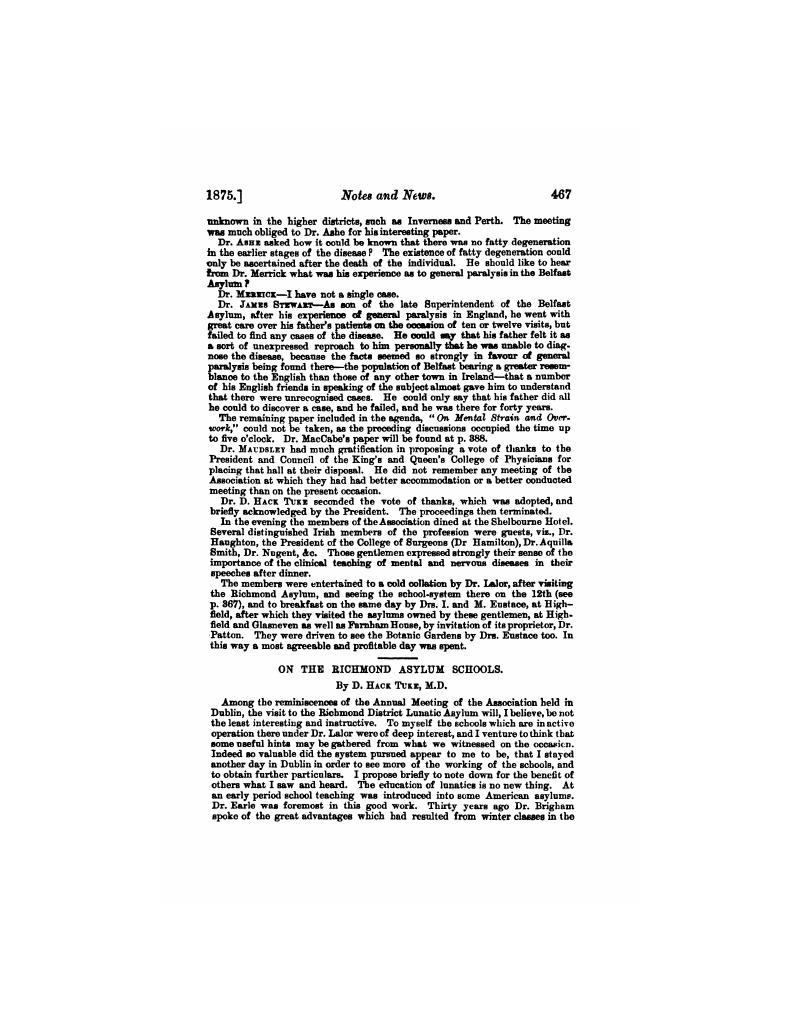No CrossRef data available.
Article contents
On the Richmond Asylum Schools
Published online by Cambridge University Press: 19 February 2018
Abstract

Information
- Type
- Part IV.—Notes and News
- Information
- Copyright
- Copyright © Royal College of Psychiatrists, 1875
References
∗ Dr. Kirkbride writes me that at the Pennsylvania Hospital, “in place of a regular schoolroom, the teachers, or as we more commonly call them ‘Companions’ to the patients, visit them in the different wards and give their instruction by reading and conversation. This tliey do regularly every day, and in all the wards. I have always felt that a well-organised school would be valuable in any large hospital as a useful occupation of the mind.”Google Scholar
American physicians have themselves been greatly struck with the appearance presented by Dr. Lalor's schools, and considered they had much to learn from them.Google Scholar
† At llanwell a school, originally under the care of a paid master, is now in charge of a patient. There are, or have been schools at the Gloucester, Sussex, Lincoln, Stafford and Carlisle asylums. At the Devon asylum there is no regular school established, but a schoolmaster from the neighbouring village attenda a couple of evenings weekly, and has a reading class, at which only a small number of the patients attend.Google Scholar
∗ Under this head are included furnished apartments, rations, vegetables, fuel, light, washing, and attendance.Google Scholar
† In a letter to the writer, Dr. Kirkbride observes most truly, “Like most other means of occupation or amusement, to be successful, it requires on the part of the Superintendent, a determination that they (schools) shall be.”Google Scholar
∗ As curable patiente would, of course, predominate among the pupils, no fair comparison can be made between the recoveries among the latter ana the total population of the asylum; but it may be stated that in 1874, 76 pupils, or 30.5 per cent, were discharged recovered, whilst the percentage of reooveries on the total number under treatment was only about II. The recoveries at this asylum from 1862 to 1874 (inclusive), reckoned on the admissions, amount to 45.5 per cent. a result which will compare satisfactorily with corresponding statistics in England, and it might not be illogical to connect the fact, in part at least, with the Bohool System pursued by Dr. Lalor. During the 13 years ending 1871, the recoveries in England and Wales were, for county and borough asylums, 35.47, and for all our asylums and hospitals, 83.87.Google Scholar
∗ The date of hie appointment.Google Scholar
† Ten yean after its establishment, the Head Inspector of National Schools made the following entry : “The experiment of bringing lunatics under regular instruction, has been attended in this place with great success. Many of them take an evident interest in the business brought before them. Discipline and order are well maintained, mind and body are kept occupied. Some write an excellent hand, and all who have copy books manifest a great interest in keeping them neat and olean. I would add that one cause of Dr. Latori tuooesa is that he has kept in view the restoration and improvement of the weakened moral, intelleo-tual and physical powers, and not merely the teaching of the three R's.”Google Scholar


eLetters
No eLetters have been published for this article.